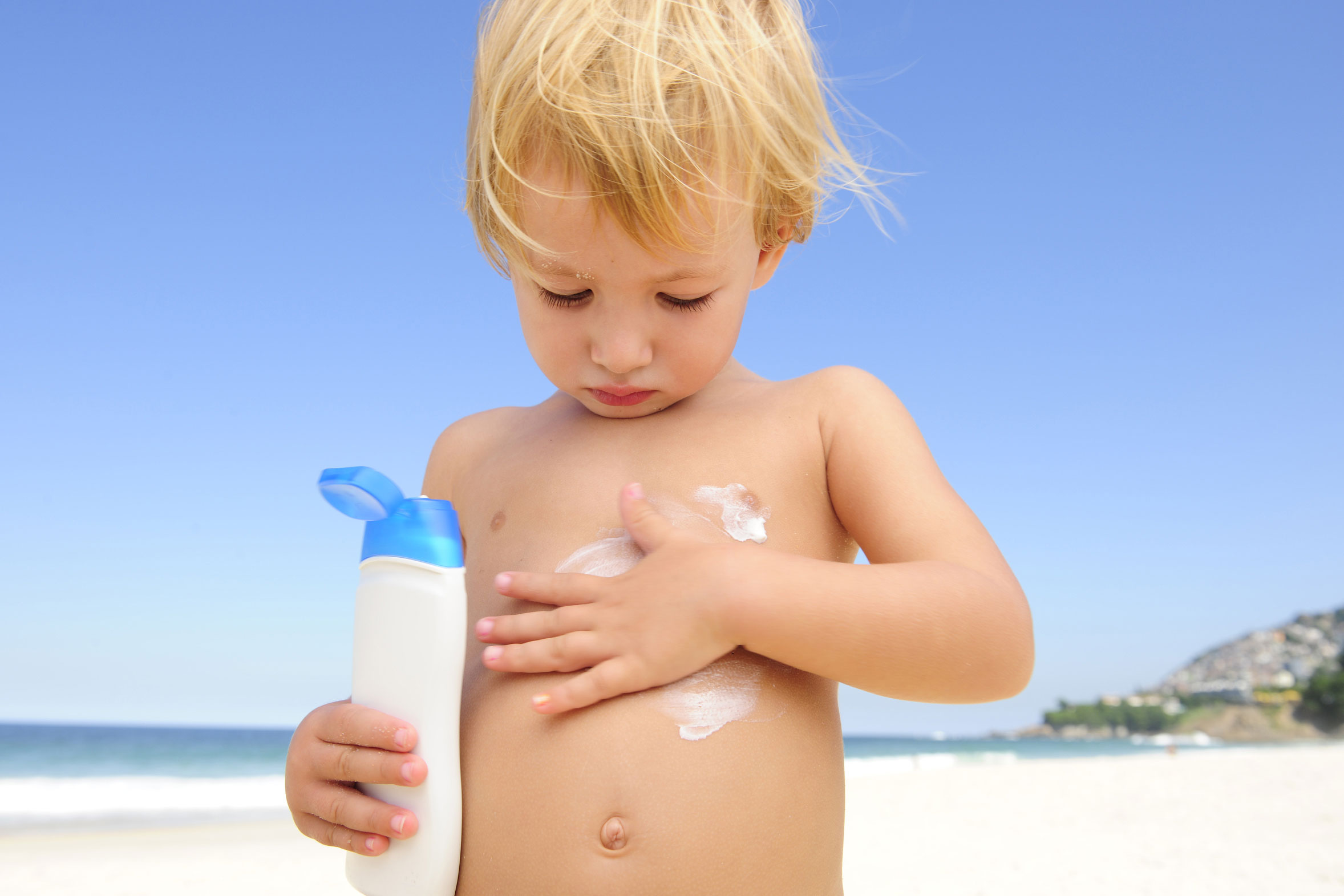How sunscreen protects our skin from ultraviolet rays

Sunscreen Manual
How sunscreen protects our skin from ultraviolet rays
JUNE DEFINITELY is one of the best periods to enjoy outdoor activities. However, it is also the time with the largest amount of ultraviolet rays coming directly from the sunlight, even though the temperature is not as high as that of July or August. Ultraviolet rays (UV), that compose a part of electromagnetic spectrum, are essential for humans as they function as sterilizers. However, when people are exposed to the ultraviolet rays for a long time, the rays can cause skin cancer in humans. To lessen those harmful effects of ultraviolet rays, it is essential for people to use sunscreen, especially in June. Then, how does sunscreen protect our skin from ultraviolet rays and what is the proper usage of sunscreen?
What are ultraviolet rays?
Sunlight emits a large amount of light energy that consists of a wide spectrum divided into infrared rays, visible rays and ultraviolet rays according to their wavelength. Out of the three, infrared rays have the longest wavelength and take a much wider range (760nm* ~ 1mm) when compared with visible rays (400nm ~ 760nm) and ultraviolet rays (100nm ~ 400nm). The three rays have energy that can lead to chemical reactions, and ultraviolet rays have much higher energy rates compared to the other two. Therefore, a proper amount of ultraviolet rays can even do sterilizing actions that can kill bacteria, or even help our body synthesize Vitamin D.
However, even though ultraviolet rays can sometimes help out our body, they are not always good for our skin, as they can damage it due to their high energy levels. They can tan our skin but also go to the extent of causing skin cancer when the skin is exposed to ultraviolet rays for prolonged time. Therefore, ultraviolet rays are usually not conveyed to humans directly, but rather blocked by the ozone layer in the stratosphere of earth. Yet still, some of the ultraviolet rays still reach the earth due to their wavelength.
Ultraviolet rays are divided into three categories, depending on their harmfulness and range of wavelength: namely UV-A, UV-B and UV-C. UV-A are ultraviolet rays that have a wavelength of 320nm ~ 400nm and can pass through glass window. As for UV-B, they are ultraviolet rays that have a wavelength of 290nm ~ 320nm which cannot pass through glass windows. Since both of them are not perfectly blocked by the ozone layer, many people are easily exposed to UV-A and UV-B. The exposure may often prematurely age human skin, causing wrinkles and age spots. To protect our skin from UV-A and UV-B, the human body makes its own immune system, through which our skin creates a kind of black pigments called melanin, which can absorb the UV-A and UV-B. Due to this procedure, we sometimes get freckles from the melanin when spending too much time under strong sunlight. However, it is wrong to judge that the two are the same. Unlike UV-A, UV-B might cause sunburn, while overexposure to UV-A might cause even more harmful effects to our skin, such as skin cancer, as it can penetrate deeper into the skin. Lastly, UV-C has the highest energy levels among the three ultraviolet rays. They have a wavelength of 100nm ~ 290nm, and are not only dangerous, but can even kill organisms that are made of a single cell. As for humans, UV-C can destroy the cornea, a transparent skin covering the outside of eyes, and even make people go blind. However, thanks to the ozone layer, UV-C is perfectly blocked and not conveyed to the ground.
How does sunscreen protect our skin?
Due to the harmfulness of ultraviolet rays, it is essential to protect our skin from aging and skin cancer. Among various solutions to block the rays, applying sunscreen on your skin might be the most simple and easiest one. Sunscreen consists of two main materials: synthetic filter and mineral filter. Synthetic filter includes materials such as p-aminobenzoic acid (PABA) and glyceryl p-aminobenzonate that change ultraviolet rays into heat energy. Sunscreens with synthetic filter can change and even destroy ultraviolet rays through the synthesis of chemical materials before the ultraviolet rays are absorbed into our skin. They are easy to apply because they are well absorbed into our skin, and are usually not sticky. However, since they are made chemically, they are not perfectly safe for our skin. For instance, synthetic filters in sunscreen can cause various side effects such as allergies for people who have sensitive skin type. Unlike PABA, mineral filter protects our skin by reflecting the ultraviolet rays on the surface of our skin. It consists of materials such as titanium dioxide and zinc oxide. Therefore, it does not cause particular skin trouble, but it is harder to apply on the skin, especially on our face, since it can make makeup thicker.
There are two indexes that show how sunscreen is effective in blocking ultraviolet rays: Sun Protection Factor (SPF) and Protection factor for UV-A (PA). SPF reflects how sunscreen can protect the skin from UV-B, as oppose to PA which reflects how sunscreen can block UV-A. SPF indicates the index of Minimal Erythema Dosage (MED)** of skin with applied sunscreen divided by the MED of skin that does not have sunscreen on. For example, if a sunscreen has SPF 15, it means that it can reduce the amount of UV-B to 1/15 of the actual amount of rays that would have been absorbed by skin without sunscreen. As for the PA index, it is often marked as PA+, PA++ or PA+++. A sunscreen with PA+++ would have the best effect to protect the skin from UV-A.

How to use the sunscreen properly
1. When should I put sunscreen on?
Even though most of the UV-C are blocked by the ozone layer, we still have to protect our skin from UV-A and UV-B rays. Therefore, we should always use sunscreen to protect our skin when there is a strong sunlight. Dermatologists even recommend using sunscreen everyday even on cloudy days, as snow, sand and water also increase the need for sunscreen because they reflect the ultraviolet rays. Moreover, UV-B are extremely strong during 10:00 – 14:00 in the spring, so it would be better not to have outdoor activities during that time.
2. How can I choose proper sunscreen?
First of all, it is important to choose sunscreen that can protect your skin against both UV-A and UV-B: a sunscreen with both PA and SPF indexes. As for SPF, you should choose sunscreen with SPF of at least 30, which blocks 97% of the ultraviolet rays. However, it is not always true that bigger SPF directly indicates better sun screening effects, since, according to research, most sunscreens that have a SPF index higher than 30 have almost the same effect. Rather, a sunscreen with a higher SPF might have more chemical materials that might harm your skin. Moreover, it is important to choose sunscreen with water resistance, considering that sunscreen can be washed off by sweating. You should also make sure that the expiration date of your sunscreen has not passed.
3. How should I apply sunscreen?
It is important to apply sunscreen everyday 15 minutes before going outdoors. Use sunscreen to generously coat your body parts that will not be covered by clothing. However, when you apply two or three sunscreen layers at once, it does not necessarily mean that it will last longer. Rather, it is important reapply the sunscreen every two hours when you spend a long time under the sunlight, to continuously protect your skin from direct sunlight. Moreover, since skin cancer can also spread from the lips, you should apply lip balm or lipstick that contains sunscreen with an SPF of 30 or more.
4. I got sunburnt even though I used sunscreen. What can I do?
You should reduce the heat by taking a cool bath and ease the discomfort caused by dryness. It is recommended to use hydrocortisone cream or moisturizer to trap the water from getting to your skin. Drinking extra water can also help prevent dehydration. When you have blisters after outdoor activities, it means that you have second-degree sunburn. It is better to leave the blisters untouched since they help your skin heal and protect you from infection. However, if the blisters cover a large area accompanied by chills or fever, you should seek immediate medical care.
- Advised by Roh Mi-ryung (Dermatologic Surgeon, Gangnam Severance Hospital)
* * *
Sunlight always gives people warmth and light. However it can also harm us by causing skin diseases especially during summer and spring, as there are more harmful ultraviolet rays that could damage our skin. Therefore, it is important to always carry a sunscreen in your bag, to prevent your skin from aging and maintain it flawless.
*1nm = 10-9m
** MED (Minimal Erythema Dosage): the length of time that takes for human skin to make an allergic reaction under the artificial UV-B

